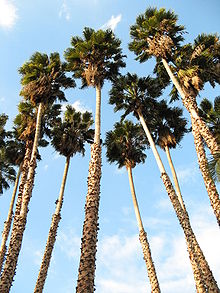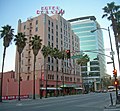bio.wikisort.org - Plant
Washingtonia robusta, known by common name as the Mexican fan palm, Mexican washingtonia, or skyduster is a palm tree native to the Baja California peninsula and a small part of Sonora in northwestern Mexico. Despite its limited native distribution, W. robusta one of the most widely cultivated subtropical palms in the world.[3] It is naturalized in Florida, California, Hawaii, Texas, parts of the Canary Islands, France, Italy, Israel, Jordan, Lebanon, Qatar, Spain, Réunion,[4][5] and Morocco.[citation needed]
| Washingtonia robusta | |
|---|---|
 | |
| Mexican washingtonias planted in Los Angeles County Arboretum and Botanic Garden | |
| Scientific classification | |
| Kingdom: | Plantae |
| Clade: | Tracheophytes |
| Clade: | Angiosperms |
| Clade: | Monocots |
| Clade: | Commelinids |
| Order: | Arecales |
| Family: | Arecaceae |
| Tribe: | Trachycarpeae |
| Genus: | Washingtonia |
| Species: | W. robusta |
| Binomial name | |
| Washingtonia robusta | |
| Synonyms[2] | |
|
Synonymy
| |
Description
W. robusta grows to 25 m (82 ft) tall, rarely up to 30 m (98 ft). The leaves have a petiole up to 1 m (3 ft 3 in) long, and a palmate fan of leaflets up to 1 metre (3 ft 3 in) long. The inflorescence is up to 3 m (10 ft) long, with numerous small, pale orange-pink flowers. The fruit is a spherical, blue-black drupe, 6–8 mm (1⁄4–5⁄16 in) diameter; it is edible, though thin-fleshed.[6]
Taxonomy
It is one of two species in the genus Washingtonia. The other is the close relative Washingtonia filifera, which occupies a more northerly distribution. Compared with W. robusta, W. filifera has a thicker trunk and dull green leaves.[7]
Nomenclature
- English: Mexican fan palm, Mexican washingtonia, skyduster
- Spanish: abanico, palma colorado, palma real, palma blanca, palma negra
- Seri: Zamij ctam
Distribution
This palm is native to the Baja California peninsula and Sonora. On the peninsula, it occurs from the Sierra de La Asamblea and the Baja California Desert south into the Vizcaino region and the Sierra de La Giganta, and into the southern cape.[8] In Sonora, it occurs in canyons in the western half of the state, particularly in the palm oases of the Sierra El Aguaje north of Guaymas. It is relatively restricted, and is suspected to be a relict population in Sonora. It has the least number of plants in the palm oases that are shared with two other more numerous species, Brahea brandegeei and Sabal uresana.[7]
Cultivation

Like the closely related Washingtonia filifera (California fan palm), it is grown as an ornamental tree. Although very similar, the Mexican washingtonia has a narrower trunk (which is typically somewhat wider at the base), and grows slightly faster and taller; it is also somewhat less cold hardy than the California washingtonia, hardy to about −8 °C (18 °F).
Field research conducted on W. robusta in its native habitat on the Baja California peninsula concluded that its potential longevity may exceed 500 years.[9]
Supporting research by Barry Tomlinson and Brett Huggett states that there is "evidence for extreme longevity of metabolically functioning cells of considerable diversity in palm stems."[10] Many of the iconic "sky dusters" of Los Angeles that have survived the chainsaws of progress are documented in photography from the 19th century.
The Mexican fan palm is normally grown in the desert Southwestern United States, in areas such as California, Arizona, southern Nevada, extreme southwestern Utah and Texas. It also cultivated in the coastal areas of South Atlantic states and the Gulf Coast, including extreme southern North Carolina, coastal South Carolina, southern Georgia, and Florida. Along the Gulf Coast, Mexican fan palms can be found growing along the Florida west coast westward to South Texas.
Washingtonia × filibusta is a hybrid of W. robusta and W. filifera, and has intermediate characteristics of the two parents, especially greater tolerance of wet cold.[11]
Gallery
- Flowering palm in Chandler, Arizona
- Infructescence
- Inflorescence
- Arizona State University's Palm Walk
- Species in Venice Beach, California
 Washingtonia Robusta growing in Saint Simons Island Georgia.
Washingtonia Robusta growing in Saint Simons Island Georgia.- Washingtonia robusta and Canary Island date palms are commonly seen lining many streets throughout San Jose, California.
- Palm trees lined up at S. Occidental Blvd between Koreatown and Westlake of Los Angeles, California
- Species line Santa Clara Street in San Jose, California
- Oldest palms in Los Angeles, planted circa 1875
- A Mexican fan palm tree in Enterprise, Alabama
References
- "Washingtonia robusta". Germplasm Resources Information Network (GRIN). Agricultural Research Service (ARS), United States Department of Agriculture (USDA). Retrieved 2010-07-17.
- The Plant List
- Felger, Richard Stephen; Johnson, Matthew Brian; Wilson, Michael Francis (2001). The Trees of Sonora, Mexico. New York, New York: Oxford University Press. p. 391. ISBN 0-19-512891-5.
- Kew World Checklist of Selected Plant Families,Washingtonia robusta
- Biota of North America Program 2014 county distribution map
- Little, Elbert L. (1994) [1980]. The Audubon Society Field Guide to North American Trees: Western Region (Chanticleer Press ed.). Knopf. p. 326. ISBN 0394507614.
- Felger, Richard S.; Joyal, Elaine (1999). "The Palms (Arecaceae) of Sonora, Mexico" (PDF). Aliso. 18: 1–18. doi:10.5642/aliso.19991801.11.
- Rebman, J. P.; Gibson, J.; Rich, K. (2016). "Annotated checklist of the vascular plants of Baja California, Mexico" (PDF). San Diego Society of Natural History. 45: 275.
- Bullock, S.H.; Heath, D. (2006). "Growth rates and age of native palms in the Baja California desert". Journal of Arid Environments. 67 (3): 391–402. Bibcode:2006JArEn..67..391B. doi:10.1016/j.jaridenv.2006.03.002.
- Tomlinson, P. Barry; Huggett, Brett A. (2012-12-01). "Cell longevity and sustained primary growth in palm stems". American Journal of Botany. 99 (12): 1891–1902. doi:10.3732/ajb.1200089. ISSN 0002-9122. PMID 23221497.
- Riffle, Robert Lee (2008). Timber Press Pocket Guide to Palms. Timber Press Pocket Guides. Portland, Oregon: Timber Press. p. 224. ISBN 978-0-88192-776-4.
External links
- Flora of North America Vol. 22 Page 106 Mexican fan palm, palmier évantail du Mexique Washingtonia robusta H. Wendland, Garten-Zeitum (Berlin). 2: 198. 1883.
- Scanpalm - Washingtonia robusta
На других языках
- [en] Washingtonia robusta
[es] Washingtonia robusta
Washingtonia robusta (palmera de abanico mexicana) es una especie de planta perteneciente a la familia Arecaceae.[ru] Вашингтония крепкая
Вашингтония крепкая (лат. Washingtonia robusta) — вид однодольных растений рода Вашингтония (Washingtonia) семейства Пальмовые (Arecaceae).Другой контент может иметь иную лицензию. Перед использованием материалов сайта WikiSort.org внимательно изучите правила лицензирования конкретных элементов наполнения сайта.
WikiSort.org - проект по пересортировке и дополнению контента Википедии










